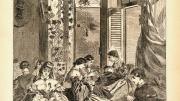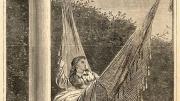On Sunday afternoons through September, The 1853 Homer House, an Italianate mansion that dominates a hill just above Belmont town center, is open for tours. Visitors are also welcome to lounge outside, drink punch, and play croquet on the home’s expansive front lawn. “We want it to feel like it is summer in the Victorian 1800s,” says the site’s volunteer curator, Susan Smart ’71, CMS ’01. She is a member of the nonprofit Belmont Woman’s Club, which saved the house—built by wealthy Boston merchant William Flagg Homer and his wife, Adeline Wellington—from demolition in 1927, and still owns it.
Guided tours highlight the largely untouched original interior architecture, along with the life and early work of the couple’s nephew, Winslow Homer. A small exhibit includes “The War—Making Havelocks for the Volunteers” (the cover of an 1861 Harper’s Weekly), which is set in the mansion’s parlor, Smart says, and “The Robin’s Note” (from an 1870 issue of Every Saturday)which“may have been set on the porch.” Smart adds that a number of Homer’s early illustrations and paintings, especially his rural landscapes, “contain Belmont scenes.” The young artist spent much of his first two decades in West Cambridge, parts of which, including his relatives’ homesite, became Belmont when that town was established in 1859.
He and his family lived nearby, but in a modest farmhouse (still standing and privately owned) because his father was a “get rich quick sort of fellow” and lost a bundle in the California gold rush, Smart explains. Homer spent time at the mansion, however, even after he moved to New York City in 1859 and began to emerge as one of the century’s finest painters. Most people associate Homer with Maine, where from 1884 until his death in 1910 he lived and worked in his Prouts Neck studio, now owned, and opened for limited tours, by the Portland Museum of Art. “There, you learn about the last years of his life,” Smart notes. “Here, you come for the young, romantic Winslow just starting out.”










